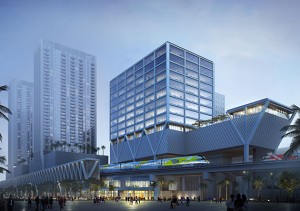There are few public issues in Miami more visible and divisive than parking.
On a broad scale, the city is studded with parking garages of all shapes and sizes, vast surface lots and now even self-parking robots, all meant to serve the nearly 2 million registered vehicles in Miami-Dade County.
Even so, many of Miami’s average Joes and Janes find themselves circling the block around their favorite restaurant, or waiting for a space to open on the street near their friend’s apartment.
But behind the scenes, a seismic shift among some developers and public officials is underway as they try to distance themselves from Miami’s notorious car-dependency in favor of a more urban and walkable city.
Legislation
The single largest factor dictating development rules for parking is zoning.
For residential projects, Miami zoning rules require a minimum of 1.5 parking spots per residence. On a small scale for single-family homes or townhouse projects, that minimum might seem small. For a development aiming at more than 100 units, however, it quickly compounds.
But recent years have seen legislators push through caveats and exemptions to the zoning code aimed at helping foster greater ridership for public transit and lessening the pressure on developers to build parking.
In October, city commissioners passed an amendment to the code that allowed developers of any new building near a transit corridor and sized under 10,000 square feet to decide how much parking they want, if any at all.
There’s also a buffer zone of 500 feet between those developments and any single-family residence, meant to prevent parking spillover in surrounding neighborhoods.

Andrew Frey
Andrew Frey, founder of development firm Tecela and the one who drafted the amendment, said the exemption was a major win for small lot owners, who might not have been able to build viable projects under the old rules.
“I’m not sure why we privilege parking spaces to such a degree, to say we would rather have no development at all than some development with less parking,” he said, adding that the exemption “promotes housing supply, reduces car dependence, and allows investment in more neighborhoods.”
Miami Beach and Coral Gables also have similar exemptions, where small buildings under a certain square footage are exempt from typical parking requirements.
On a much larger scale, the city of Miami has moved to promote urbanism in its central business district by completely waiving parking requirements for its densest areas within 1,000 feet of a Metromover or Metrorail station. To date, only a handful of major residential projects have taken advantage of that waiver, including the Related Group’s Loft 1, Loft 2 and myBrickell condominiums, as well as Harvey Hernandez’s soon-to-open Centro tower. None of those projects have on-site parking.
Commissioner Francis Suarez, who was a major proponent of Frey’s amendment, said the city of Miami has had a progressive attitude toward parking reductions, though it could still do more to help alleviate the now routine traffic jams in its major arteries.
“If you look at all big cities, they marry land-use and planning with transportation,” he said. “That’s what we need to be doing within here.”
Walkability
Take one look at a map of Miami and you’ll quickly realize it’s tough to get anywhere outside of the downtown area without a car. It should come as no surprise then that the city ranked poorly on a recent walkability study from real estate advocacy group LOCUS and the Center for Real Estate and Urban Analysis at the George Washington University School of Business.
Of the 30 major U.S. metropolitan areas examined by the study, the Miami metro — including Palm Beach and Broward counties — ranked 22 for its mix of walkable urban neighborhoods. The study took into account how much office, retail and multifamily space are located in a city’s walkable areas to arrive at its ranking.

Rendering of Brickell City Centre
For Miami, a mere 8 percent of retail and multifamily space are in walkable urban areas, while 18 percent of its offices are in places easily accessible by foot, according to the study.
Now compare that to New York City, which took the study’s top spot for walkability. The metro had 55 percent of its offices in walkable areas, along with 39 percent of its apartments and 13 percent of its retail space.
It wasn’t always like this, though. When migrants were first carving South Florida out of swampland in the late 19th and early 20th centuries, Henry Flagler’s railroad was the region’s lifeline. But with the massive popularity of affordable automobiles in the mid-20th century, new public transit projects all but evaporated.
That’s all set to change in the future, according to LOCUS President Chris Leinberger.

Rendering of MiamiCentral
Although Miami ranked low for its current walkability in the study, the metropolitan area was ninth in the country for new urban development.
New projects like the soon-to-open Brickell City Centre development, which has offices, retail, residential and hospitality components, are incorporating existing mass transit like the Metromover in their plans.
All Aboard Florida’s new commuter service Brightline will connect downtown Miami, Fort Lauderdale and West Palm Beach with a high-speed train starting next year. And in Fort Lauderdale, transit-oriented development is being revived in hot new neighborhoods like Flagler Village ahead of the planned Wave streetcar project.
Even ride-sharing companies like Uber and Lyft are starting to change public perceptions, and with their futures secured in Miami-Dade thanks to a recent commission vote on their legality, they can continue offering an alternative option to current mass transit.
“Miami…has turned the corner in this real estate cycle and is aggressively building walkable urban areas,” Leinberger said.
Developer’s Perspective
Figuring out how much parking to build alongside a residential project can be a bit of an art form, according to Harvey Hernandez of the Newgard Development Group.
It depends heavily on the land you own — its shape, size and whether there’s existing parking around — as well as who your end user is going to be.

Harvey Hernandez, managing director of Newgard Development Group.
For his firm’s latest project in the downtown area, the Centro condominium, Hernandez squeezed a 36-story building with 352 units on a slender lot measuring only 22,000 square feet.
The only way he could make that project work, he said, is without parking. Not a single spot was built alongside Centro, and Hernandez credits the city’s 100 percent parking waivers in the central business district and Centro’s location a block away from a Metromover station as the main reasons he could make it happen.
Besides land restrictions, the other big incentive for nixing parking in a building is pure economics. Hernandez said parking podiums can cost $20,000 to $30,000 per spot, so savings quickly add up for any reductions. And the fewer spaces you build, the more saleable or rentable square footage you can add to the project.
“When each parking spot is 400, 425 square feet, you end up building more square footage for a parking space than for a unit,” he said. With those savings in both cost and space, Hernandez can lower unit prices. Condos at Centro cost between the mid $300,000s up to $550,000.
But while those innovations might work for Centro, a cool new condominium aimed at young working professionals, the same wouldn’t be applicable for a luxury project where buyers expect to have parking.
With that in mind, Hernandez built a flashy condo tower in 2014 called BrickellHouse with a concept not often seen in Miami — a robotic parking garage. He said although the system cost him 20 percent to 25 percent more than a typical garage, it was much more efficient, squeezing the space requirements per spot down to 250 square feet.
Robotic garages are also much more flexible in their placement, he said. Unlike the typical square-shaped podium, Hernandez was able to build BrickellHouse perpendicular to its lot, hiding the garage’s entrance from street view.
His firm’s innovations, however, were not without controversy. The garage’s robotic systems were riddled with problems and residents complained of waiting hours to retrieve their cars. Amid the quagmire, the company that operated BrickellHouse’s garage went bankrupt and the building’s condo association filed a lawsuit against Hernandez’s firm.
“Call me crazy, but it hasn’t turned me off [of robotic parking garages],” he said. “We have learned a lot from this experience. Every time you have a brand new technology there is a learning curve.”
Carlos Melo, principal of the Melo Group, developers of Aria on the Bay in Edgewater and Melody in the Arts & Entertainment District, has so far met the city’s requirements of 1.5 parking spaces per unit. But he sees a new trend on the horizon.
“The city is changing,” he said. “We have to realize this is going to be a carless city like New York or Buenos Aires.”
